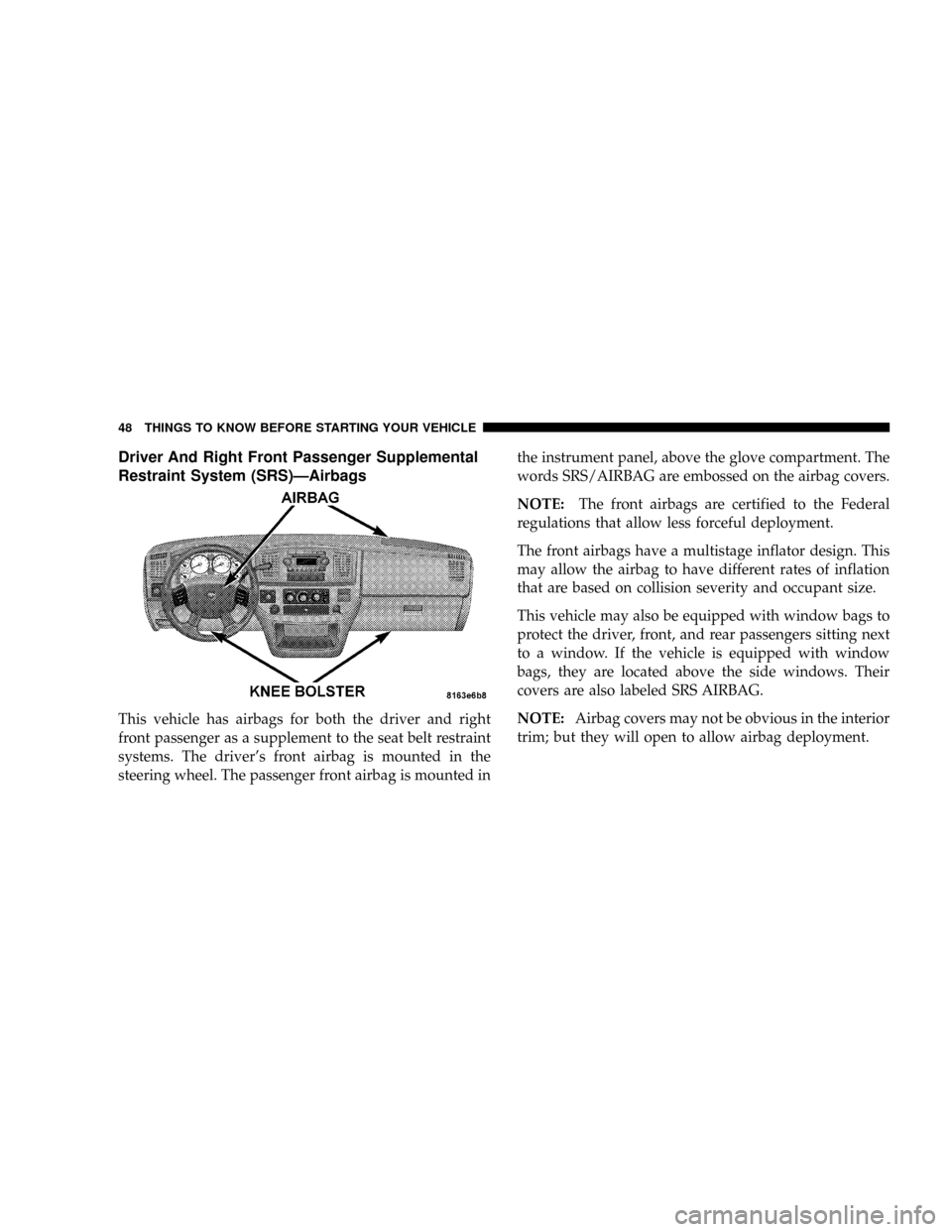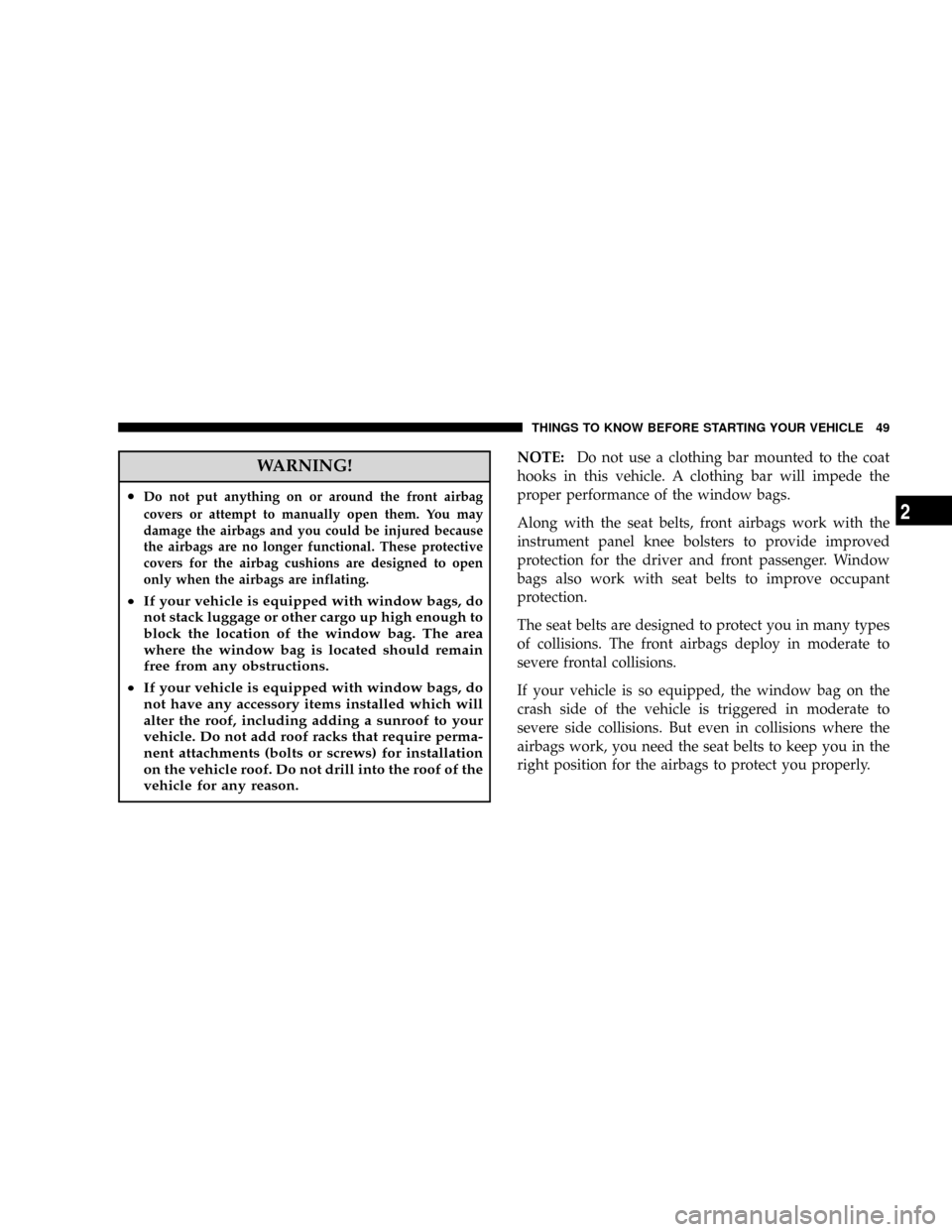Page 3 of 554
TABLE OF CONTENTSSECTIONPAGE
1INTRODUCTION.............................................................3
2THINGS TO KNOW BEFORE STARTING YOUR VEHICLE...............................9
3UNDERSTANDING THE FEATURES OF YOUR VEHICLE...............................81
4UNDERSTANDING YOUR INSTRUMENT PANEL................................... 189
5STARTING AND OPERATING................................................. 273
6WHAT TO DO IN EMERGENCIES...............................................415
7MAINTAINING YOUR VEHICLE............................................... 441
8MAINTENANCE SCHEDULES.................................................. 513
9IF YOU NEED CONSUMER ASSISTANCE..........................................521
10INDEX....................................................................531
1
2
3
4
5
6
7
8
9
10
Page 9 of 554
VEHICLE IDENTIFICATION NUMBER
The Vehicle Identification Number (VIN) is found on the
left front corner of the instrument panel, visible through
the windshield. This number also appears on the Auto-
mobile Information Disclosure Label affixed to a window
on your vehicle, the vehicle registration and title.NOTE:It is illegal to remove the VIN.VEHICLE MODIFICATIONS/ALTERATIONS
WARNING!
Any modifications or alterations to this vehicle could
seriously affect its roadworthiness and safety and
may lead to an accident resulting in serious injury or
death.
Vehicle Identification Number
INTRODUCTION 7
1
Page 16 of 554
Manual TransmissionÐIf Equipped
When the steering wheel is in the LOCK position, the
steering and ignition systems are locked to provide
anti-theft protection for your vehicle. It may be difficult
to turn the key from the LOCK position when starting
your vehicle. Move the steering wheel left and right
while turning the key until it turns easily. To remove the
key, depress and hold the release button located between
the ignition switch and the instrument panel. Turn the
ignition key to LOCK and remove the key.
Locking Doors With The Key
You can insert the key with either side up. To lock the
door, turn the key rearward. To unlock the door, turn the
key forward. See Section 7 of this manual for door lock
lubrication.
Ignition Key Release Button
14 THINGS TO KNOW BEFORE STARTING YOUR VEHICLE
Page 21 of 554

disengage it. If you turned the wheel to the left to engage
the lock, turn the wheel slightly to the left to disengage it.
Automatic Transmission Ignition Interlock System
This system prevents the key from being removed unless
the shift lever is in PARK. It also prevents shifting out of
PARK unless the key is in the ON positions, and the
brake pedal is depressed.
SECURITY ALARM SYSTEM Ð IF EQUIPPED
This system monitors the vehicle doors and ignition for
unauthorized operation. When the alarm is activated, the
system provides both audible and visible signals. For the
first three minutes the horn will sound and the headlights
and security telltale will flash repeatedly. For an addi-
tional 15 minutes only, the headlights and security telltale
will flash. The engine will run only if a valid Sentry Keyt
is used to start the vehicle. Use of the Sentry Keytwill
disable the alarm.
Rearming of the System:
The Security Alarm System will rearm itself after the 15
additional minutes of headlights and security telltale
flashing, if the system has not been disabled. If the
condition which initiated the alarm is still present, the
system will ignore that condition and monitor the re-
maining doors and ignition.
To Set the Alarm
The alarm will set when you use the power door locks, or
use the Remote Keyless Entry (RKE) Transmitter to
LOCK the doors. After all the doors are locked and
closed, the SECURITY light in the instrument cluster will
flash rapidly to signal that the system is arming. The
SECURITY light in the instrument panel cluster will flash
rapidly for about 16 seconds to indicate that the alarm is
being set. After the alarm is set, the SECURITY light will
flash at a slower rate to indicate that the system is armed.
THINGS TO KNOW BEFORE STARTING YOUR VEHICLE 19
2
Page 50 of 554

Driver And Right Front Passenger Supplemental
Restraint System (SRS)ÐAirbags
This vehicle has airbags for both the driver and right
front passenger as a supplement to the seat belt restraint
systems. The driver's front airbag is mounted in the
steering wheel. The passenger front airbag is mounted inthe instrument panel, above the glove compartment. The
words SRS/AIRBAG are embossed on the airbag covers.
NOTE:The front airbags are certified to the Federal
regulations that allow less forceful deployment.
The front airbags have a multistage inflator design. This
may allow the airbag to have different rates of inflation
that are based on collision severity and occupant size.
This vehicle may also be equipped with window bags to
protect the driver, front, and rear passengers sitting next
to a window. If the vehicle is equipped with window
bags, they are located above the side windows. Their
covers are also labeled SRS AIRBAG.
NOTE:Airbag covers may not be obvious in the interior
trim; but they will open to allow airbag deployment.
48 THINGS TO KNOW BEFORE STARTING YOUR VEHICLE
Page 51 of 554

WARNING!
²Do not put anything on or around the front airbag
covers or attempt to manually open them. You may
damage the airbags and you could be injured because
the airbags are no longer functional. These protective
covers for the airbag cushions are designed to open
only when the airbags are inflating.
²If your vehicle is equipped with window bags, do
not stack luggage or other cargo up high enough to
block the location of the window bag. The area
where the window bag is located should remain
free from any obstructions.
²If your vehicle is equipped with window bags, do
not have any accessory items installed which will
alter the roof, including adding a sunroof to your
vehicle. Do not add roof racks that require perma-
nent attachments (bolts or screws) for installation
on the vehicle roof. Do not drill into the roof of the
vehicle for any reason.
NOTE:Do not use a clothing bar mounted to the coat
hooks in this vehicle. A clothing bar will impede the
proper performance of the window bags.
Along with the seat belts, front airbags work with the
instrument panel knee bolsters to provide improved
protection for the driver and front passenger. Window
bags also work with seat belts to improve occupant
protection.
The seat belts are designed to protect you in many types
of collisions. The front airbags deploy in moderate to
severe frontal collisions.
If your vehicle is so equipped, the window bag on the
crash side of the vehicle is triggered in moderate to
severe side collisions. But even in collisions where the
airbags work, you need the seat belts to keep you in the
right position for the airbags to protect you properly.
THINGS TO KNOW BEFORE STARTING YOUR VEHICLE 49
2
Page 53 of 554

5. The driver and front passenger seats should be moved
back as far as practical to allow the airbag room to inflate.
6. If your vehicle has window bags, do not lean against
the door or window, airbags will inflate forcefully into
the space between you and the door.
7. If the airbag system in this vehicle needs to be
modified to accommodate a disabled person, contact the
Customer Center. Phone numbers are provided in the9If
You Need Customer Assistance9section later in this
owner's manual.WARNING!
²Relying on the airbags alone could lead to more
severe injuries in a collision. The airbags work
with your seat belt to restrain you properly. In
some collisions the airbags won't deploy at all.
Always wear your seat belts even though you have
airbags.
²Being too close to the steering wheel or instrument
panel during airbag deployment could cause seri-
ous injury. Airbags need room to inflate. Sit back,
comfortably extending your arms to reach the
steering wheel or instrument panel.
²If the vehicle has window bags, they also need
room to inflate. Do not lean against the door or
window. Sit upright in the center of the seat.
THINGS TO KNOW BEFORE STARTING YOUR VEHICLE 51
2
Page 54 of 554

Airbag System Components
The airbag system consists of the following:
²Occupant Restraint Controller
²Side Remote Acceleration Sensors (if equipped)
²Airbag Warning Light
²Driver Airbag
²Passenger Airbag
²Window Bags above Side Windows (if equipped)
²Steering Wheel and Column
²Instrument Panel
²Interconnecting Wiring
²Knee Impact Bolsters
²Front Acceleration Sensors (1500 Vehicles Only)
²Driver and Front Passenger Seat Belt Pretensioners (if
equipped)
²Driver Seat Track Position Sensor (if equipped)
²Passenger Side Frontal Airbag ON/OFF Switch (2500/
3500 Regular Cab Vehicles Only)
²Passenger Airbag Disable (PAD) Indicator Light
(2500/3500 Regular Cab Vehicles Only)
How the Airbag System Works
²
TheOccupant Restraint Controller (ORC)determines
if a frontal collision is severe enough to require the
airbags to inflate. The front airbag inflators are de-
signed to provide different rates of airbag inflation
from information provided by the ORC. The ORC will
not detect rollover or rear collisions.
The ORC also monitors the readiness of the electronic
parts of the system whenever the ignition switch is in
52 THINGS TO KNOW BEFORE STARTING YOUR VEHICLE